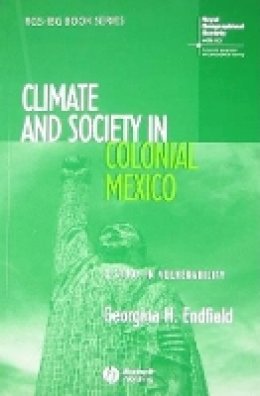
Stock image for illustration purposes only - book cover, edition or condition may vary.
Climate and Society in Colonial Mexico: A Study in Vulnerability
Georgina H. Endfield
€ 41.47
FREE Delivery in Ireland
Description for Climate and Society in Colonial Mexico: A Study in Vulnerability
Paperback. By considering three case study regions in Mexico during the Colonial era, Climate and Society in Colonial Mexico: A Study in Vulnerability examines the complex interrelationship between climate and society and its contemporary implications. Series: RGS-IBG Book Series. Num Pages: 248 pages, black & white illustrations, black & white tables, maps, figures. BIC Classification: 1KLCM; JH; RBP; RG. Category: (P) Professional & Vocational. Dimension: 229 x 153 x 14. Weight in Grams: 368.
By considering three case study regions in Mexico during the Colonial era, Climate and Society in Colonial Mexico: A Study in Vulnerability examines the complex interrelationship between climate and society and its contemporary implications.
By considering three case study regions in Mexico during the Colonial era, Climate and Society in Colonial Mexico: A Study in Vulnerability examines the complex interrelationship between climate and society and its contemporary implications.
- Provides unique insights on climate and society by capitalizing on Mexico’s rich colonial archives
- Offers a unique approach by combining geographical and historic perspectives in order to comprehend contemporary concerns over climate change
- Considers three case study regions in Mexico with very different cultural, economic, and environmental characteristics
Product Details
Format
Paperback
Publication date
2008
Publisher
John Wiley and Sons Ltd United Kingdom
Number of pages
248
Condition
New
Series
RGS-IBG Book Series
Number of Pages
248
Place of Publication
Hoboken, United Kingdom
ISBN
9781405145824
SKU
V9781405145824
Shipping Time
Usually ships in 7 to 11 working days
Ref
99-1
About Georgina H. Endfield
Georgina H. Endfield is a Reader in Environmental History in the School of Geography at the University of Nottingham. She has published papers in a wide variety of journals, including the Annals of the Association of American Geographers and the Transactions of the Institute of British Geographers, and is winner of a Philip Leverhulme Prize. She is editor of the journal Environment and History.
Reviews for Climate and Society in Colonial Mexico: A Study in Vulnerability
Mexico is well known for its vulnerability to a variety of disasters, ranging from droughts and floods to devastating epidemics. Using extensive archival resources in Mexico and Spain, environmental historian Endfield (Univ. of Nottingham) focuses on three regions with their diverse environments
the Rio Conchos Basin in the state of Chihuahua, Guanajuato and the Chichimec territory, and the Valley of Oaxaca
to compare and contrast the impact of climate crises on the economic and social-political systems of the agrarian Indian and Spanish societies of colonial Mexico from 1521 to 1820. The author discusses climate disasters of the late pre-Hispanic period, as well as the prehistory of the three study regions. Repeated climate events resulted in societal disruption, demographic changes, and conflict. Endfield shows how the societies in these three regions coped with and adapted to the risks and hazards of extreme weather over the centuries. This impressive archival study on Mexico provides a historical perspective on environmental change and the cultural response in such detail and depth that it will be used by many disciplines as global warming produces more frequent and devastating climate events in Mesoamerica and elsewhere. Summing Up: Highly recommended. Upper-division undergraduates and above.
J. B. Richardson III, University of Pittsburgh (Choice, February 2009)
the Rio Conchos Basin in the state of Chihuahua, Guanajuato and the Chichimec territory, and the Valley of Oaxaca
to compare and contrast the impact of climate crises on the economic and social-political systems of the agrarian Indian and Spanish societies of colonial Mexico from 1521 to 1820. The author discusses climate disasters of the late pre-Hispanic period, as well as the prehistory of the three study regions. Repeated climate events resulted in societal disruption, demographic changes, and conflict. Endfield shows how the societies in these three regions coped with and adapted to the risks and hazards of extreme weather over the centuries. This impressive archival study on Mexico provides a historical perspective on environmental change and the cultural response in such detail and depth that it will be used by many disciplines as global warming produces more frequent and devastating climate events in Mesoamerica and elsewhere. Summing Up: Highly recommended. Upper-division undergraduates and above.
J. B. Richardson III, University of Pittsburgh (Choice, February 2009)
